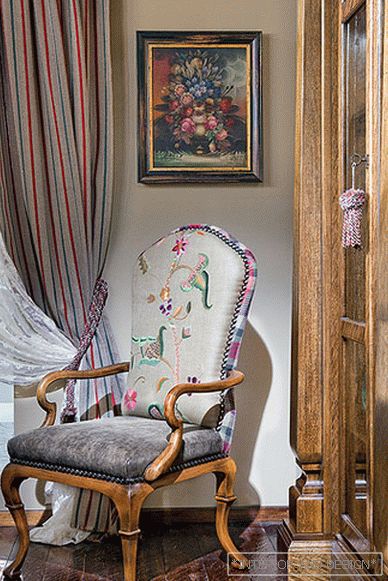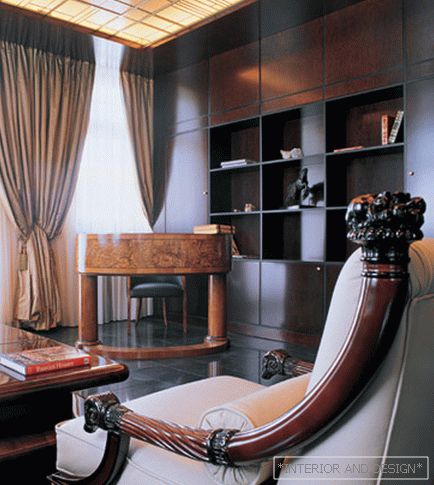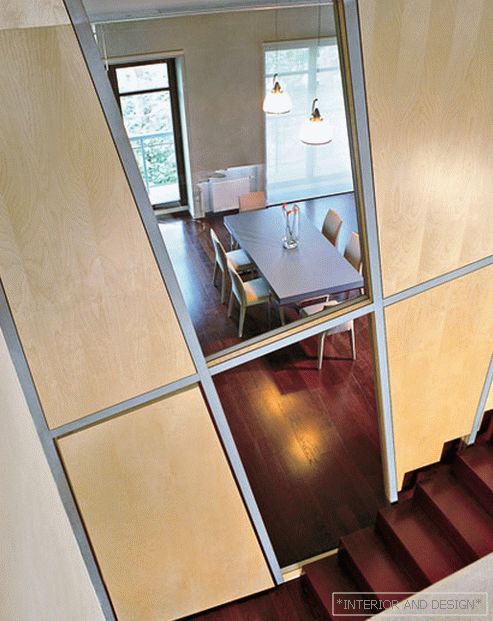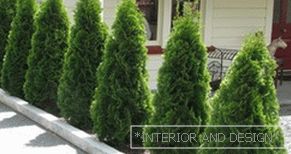 Pyramidal thuja is a representative of the western variety of the plant, when grown in nature, in northeastern America, reaches 30 meters in height, but cultivated varieties grow only up to 12 meters.
Pyramidal thuja is a representative of the western variety of the plant, when grown in nature, in northeastern America, reaches 30 meters in height, but cultivated varieties grow only up to 12 meters.
Kolonovidnaya, as it is also called, thuja, has the color of a crown with a red tint, sometimes brown-gray color. Old trees are characterized by flaking of the crown, and young representatives have a cone-shaped or pyramidal shape. In trees, the needles grow densely on shoots and last for about 2–3 years, have a rich green color in summer, and a brownish tint appears in winter.
Thuy pyramidal retain viability over 100 years, although there are cases of longer existence of trees. A very viable tree is characterized by slow growth, it develops better on loamy soils, but does not show special requirements for the soil.
If growth occurs on depleted soils, then the plant is distinguished by a yellowish color of needles. It tolerates dry years, although it loves wet land and places with high atmospheric humidity. After 70 years of life, dying off and falling off of the lower branches begin, which makes the thuya less beautiful. It grows well in all latitudes of Russia.
Despite its high growth, it is excellent in resisting wind loads; Tuyu trimmed, the tree does not deteriorate because of this; shearing does not affect further growth, nor does the transplant.
Content
- 1 Breed features
- 1.1 Tree planting conditions
- 1.2 Growth Features
- 1.3 Care for thuja pyramidal
- 2 Western thuja
- 2.1 Planting and care of the western tui species
- 2.2 Varieties of western thuja
Breed features
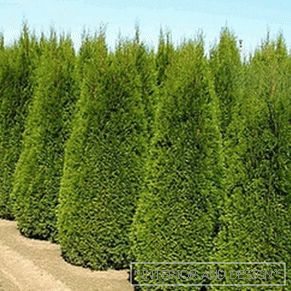 An abundance of cones, which acquire a chocolate color by the beginning of autumn, often becomes a problem of the thuja, which makes the tree look brown-green. After they fall away in a year, the crown becomes friable. The summer drought can affect the formation of such seeds. Sometimes it is found that some thuja legs have turned brown and dried.
An abundance of cones, which acquire a chocolate color by the beginning of autumn, often becomes a problem of the thuja, which makes the tree look brown-green. After they fall away in a year, the crown becomes friable. The summer drought can affect the formation of such seeds. Sometimes it is found that some thuja legs have turned brown and dried.
You should not be afraid of this, if the process does not affect more than a quarter of the crown, this phenomenon refers to the natural change of needles. Although it is referred to as evergreen trees, the needles change every 3–5 years.
Tree planting conditions
For effective growth and development should comply with certain conditions:
- Thuja breeding occurs by seeds, which require a certificate for effective growth, sometimes cuttings by green shoots are used;
- it is desirable to plant in wet soil, but in the absence of the tree will cope with dry conditions of "living";
- copes with shading, but sunlight is desirable;
- the critical temperature below which the thuja does not withstand is the reading of the thermometer below 36 ° C;
- when planting, the roots must be buried at least 80 cm;
- in the process of growth does not release toxic substances into the environment for people and animals.
Growth features
After landing in suitable conditions, observe development rules:
- soil acidity should be in the range of 5.3–7;
- thuja develops most efficiently when precipitation ranges from 900–1500 mm per year;
- when growing, it is recommended not to exceed a density per hectare of more than 3 thousand specimens;
- thuja is not very demanding for growing land, but prefers fertile soils or their average indices;
- the tree has no resistance to salinization of the earth, thuja requires highly nitrogenous, calcareous soils.
Thuja seeds are formed in cones of two pieces, ripening is achieved in the autumn period. Growing seedlings occurs within 5 years, the soil of the local climate prepares the plant for the harsh conditions of Russia. It is advisable to choose a sunny place and nutritious land.
Seeds are sown in the spring in the spring of no more than 5 cm depth. The landing site is covered with a small layer of sawdust from coniferous wood. Although young trees love the sun, but the seedlings that make their way are very sensitive to it, therefore it is not recommended to expose them to open rays, it is necessary to shade the places of shoots.
Irrigation and loosening of the soil is regularly recommended, and fertilizer should be diluted at a ratio of 1:20 slurry, in which young seedlings grow very well. For grafting, shoots are taken from shoots at the age of 2-3 years. Urgent disembarkation allows the use of an outgrowth of one year, but at the same time it needs to be buried with a piece of old trunk, so that the cutting soon took root.
Before planting, the processes are necessarily treated with heteroauxin. For the best growth a mixture of turf and peat is prepared in a ratio of 1: 1. Seedlings - cuttings are buried in the soil to a depth of at least 1.7–2.6 cm. Greenhouses, where necessary conditions are created, are considered the best place to grow seedlings.
Care for thuja pyramidal
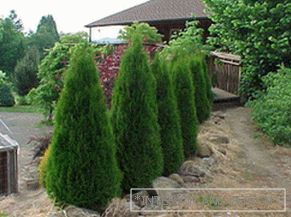 Under normal conditions, it is recommended to water the tui. The description of the breed speaks of its endurance in the arid climate, but frequent rains have a beneficial effect on the correct formation of the pyramidal crown. If the thuja is not ennobled, then the decorative qualities of the tree do not appear, the plant loses its beauty.
Under normal conditions, it is recommended to water the tui. The description of the breed speaks of its endurance in the arid climate, but frequent rains have a beneficial effect on the correct formation of the pyramidal crown. If the thuja is not ennobled, then the decorative qualities of the tree do not appear, the plant loses its beauty.
Regular watering does not allow the tree to receive reinforced dressing nutrient solutions, which lead to abundant appearance on the crown of cones with seeds. Such a tree acquires asymmetrical forms and beauty, therefore, cones and dead needles should be removed every spring.
If required, it is possible to repot thuyu, as the tree easily transfers this procedure. The change of place does not cause difficulties for the gardener, since the rhizomes of the tree are collected in a compact tuber. Therefore, if there are suspicions about the wrong landing site, then it can be changed. Some varieties of thuja for the winter are tied up with ropes so that the snow does not harm the shape of the tree, other varieties are forced to be in such a bundle all the time.
Regularly, but in moderation, it is necessary to produce thuja fertilizer, you need to start in early spring, when there is snow. During this period, apply nitrogen fertilizer, the next stage of fertilizer begins in June, using potassium solutions. Trees growing on depleted land support trees with phosphorus solutions.
Description of the properties of the tree says that the crown is exposed to the pest, which is called false scale. Gardeners successfully struggle with this problem by using karbofos and aktelik in early spring. They are sprinkled with a crown of thuja before leafing and two more times in the summer and once in the autumn. The same drug destroys aphids on the branches and needles of the tree. Types of decorative pyramidal thuja
In the natural pool grow several types of wood:
- eastern;
- Japanese
- Korean
- folded;
- western.
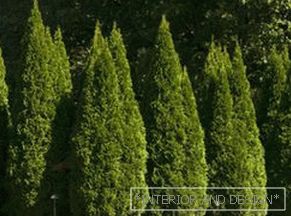 Eastern thuja characterized by a fan-shaped branch, brought from China, hence its inability to withstand long and severe frosts. In the middle zone, the breed is planted only in the shade of nearby tall trees, it grows better and develops in the southern regions of Russia. According to its therapeutic indicators it is used to alleviate many diseases.
Eastern thuja characterized by a fan-shaped branch, brought from China, hence its inability to withstand long and severe frosts. In the middle zone, the breed is planted only in the shade of nearby tall trees, it grows better and develops in the southern regions of Russia. According to its therapeutic indicators it is used to alleviate many diseases.
Japanese pyramid thuja a native of the Japanese island, where it grows in the mountainous coniferous-deciduous forests, at a height above the sea up to 1700 m. It has the original color of the needles - spotted below, covered with a green layer from above. It grows up to 18 meters in height and is characterized by a smoky-fir smell. It is unpretentious, withstand strong and prolonged frosts and take root in the Arctic. For a long time withstands dry anhydrous climate, grown in all latitudes. Poorly tolerates the polluted atmosphere of cities, requires clean air.
Thuja korean more like a shrub in terms of growth, comes from the forested areas of the peninsula of Korea, where it does not occur very often. It has a sprawling large crown, which differs in original color, one tree can have rich green tones and silver colors in different places. In Russia, it is grown in the southern regions, since it does not tolerate cold snaps.
thuja plicata also does not like the manifestation of cold, but its peculiarity is that the shoots caught by the frost restore their properties after thawing. Such a tree grows up to the height of a twenty-story house, some specimens reach a thickness of two meters. It has a pyramidal crown shape, emits a pleasant peculiar smell. Originally from the Canadian west coast.
Western thuja
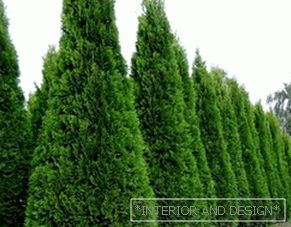 The most common species is the western thuja, which is demanded by gardeners because of its ability to withstand severe frosts and undemanding to growing conditions. This type of thuja has the largest number of varieties and forms, the period of life is 100 years or more. Among gardeners amateurs are most used for planting dwarf, weeping, variegated, miniature species of western thuja.
The most common species is the western thuja, which is demanded by gardeners because of its ability to withstand severe frosts and undemanding to growing conditions. This type of thuja has the largest number of varieties and forms, the period of life is 100 years or more. Among gardeners amateurs are most used for planting dwarf, weeping, variegated, miniature species of western thuja.
It is suitable for disembarking in various regions of Russia, except for our country, the countries of Western Europe are engaged in its breeding. Most varieties of western thuja do not lose their crown shape even when grown in fully shaded conditions. It prefers light loamy lands, if planted in sandy soils, it requires constant feeding. Resistant pollution of urban air. Thuja is very popular for creating decorative green fences and live fences.
Planting and caring for the western tui view
It is recommended to land in a place protected from the wind. For the effective cultivation of seedlings should prepare a mixture of turf soil, peat and sand in a ratio of 2: 1: 1. Allowed to add to this composition 500 grams of nitroammophosphate for planting a single tree. When planting, it is recommended to leave the root collar uncovered.
After planting, it is necessary to ensure good watering in the amount of ten liters per tree per day during sprinkling. If it is dry and hot summer, the amount of moisture is increased to 20 liters and produce watering only in the morning and in the evening, the daytime hours leave the tree to rest. If the thuja receives insufficient moisture, then its crown is characterized by the formation of cones with seeds, becomes ugly, loses its elastic form and the decorativeness of the tree is lost.
If fertilizers were used for planting the tree, then fertilizing is carried out only the next year. The plant, planted without the use of mineral substances, is fed in the first year in early spring and twice during the summer period. Young seedlings should be protected from direct sunlight. to prevent burns.
Western Tui species
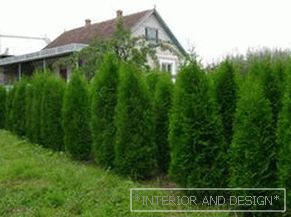 Pyramid thuja Dense by description has a narrow crown in the form of a cone, grows up to 10 meters in height. Dense short shoots branch and densely fit in the crown to each other. The tree has needles in the form of green flakes with a weak brilliant effect. Breed well maintains a winter climate, it is recommended as a single tree, and for landing in group of a green hedge.
Pyramid thuja Dense by description has a narrow crown in the form of a cone, grows up to 10 meters in height. Dense short shoots branch and densely fit in the crown to each other. The tree has needles in the form of green flakes with a weak brilliant effect. Breed well maintains a winter climate, it is recommended as a single tree, and for landing in group of a green hedge.
Western Equal Thuja grows to a height of 15 meters. The shape of the crown is similar to cypress, numerous branches contain tightly pressed needles, which are directed slightly down. It was bred in Germany, it is characterized by rapid growth and, unlike other species, retains its green color even in winter.
Western thuja Brabant grows to 15–20 meters, characterized by a sprawling coniferous crown with a diameter of up to 4 meters, smoothly turning into a cone. Scaly needles retain juicy color in the winter. The tree is undemanding to soil conditions, grows well in dry and wet lands. Tolerates transplant and haircut, quite unpretentious.
Variety of Western Thuy Vervain it is distinguished by a sophisticated beautiful crown, representing a narrow cone. Numerous thin branches form a soft and dense crown of yellow and green colors of light shades. The variety is bred in Belgium, preferably planted in alleys near houses.
The Malonyan variety, grown in Slovakia, has a narrow-leaved form, densely located numerous shoots are collected in a sharp apical form with shiny needles with a ferruginous shade. It tolerates frosts for a long time.
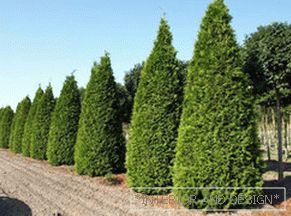 A variety of western Tui Smaragd has a standard shape in the form of a pyramid, but of a more squat form, a low tree grows in height to 4–5 meters. Grown as a single tree or in a group of similar trees to create a decorative fence or planting along the avenue. If a planned multi-row landing, then Smaragd is well suited for creating backgrounds.
A variety of western Tui Smaragd has a standard shape in the form of a pyramid, but of a more squat form, a low tree grows in height to 4–5 meters. Grown as a single tree or in a group of similar trees to create a decorative fence or planting along the avenue. If a planned multi-row landing, then Smaragd is well suited for creating backgrounds.
Variety Holmstrup is a shrub that rises to 4 meters with a crown in diameter up to 1 m. The shape of the tree resembles a cone, The branches have a reddish bark or a grayish shade and dense scaly green needles. There is a slow growth, only about 10 centimeters per year, it grows very well in the shade, it develops in dry and moist soil. Easily tolerates frosts.
Thuja is very popular, cultivation in private courtyards and public squares allows you to create a beautiful ensemble to decorate the area.

